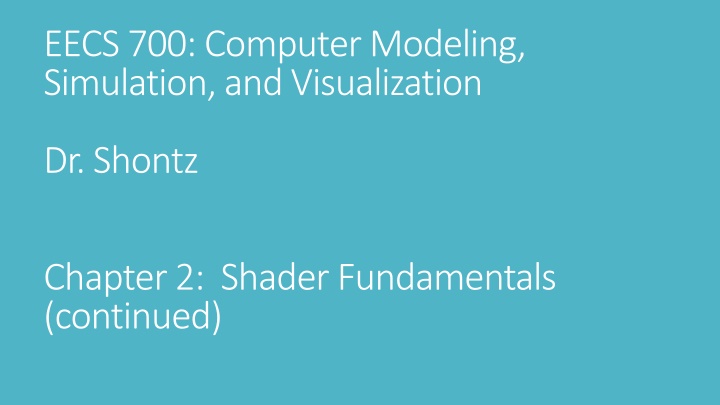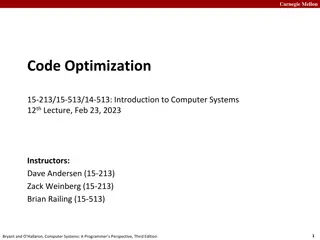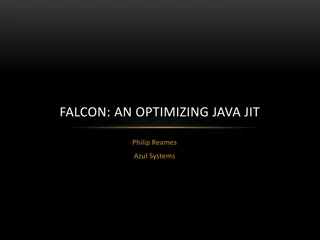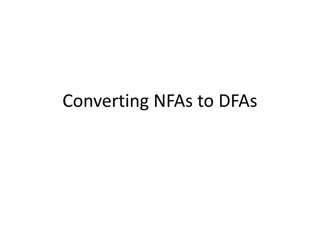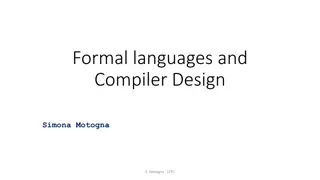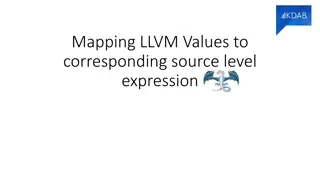Shader Fundamentals: Compiler Control and Global Options
Understanding how shaders are compiled with optimization control using pragma directives, managing shader processing in extension blocks, organizing shader variables into blocks, specifying uniform blocks, and controlling layout with qualifiers.
Download Presentation

Please find below an Image/Link to download the presentation.
The content on the website is provided AS IS for your information and personal use only. It may not be sold, licensed, or shared on other websites without obtaining consent from the author.If you encounter any issues during the download, it is possible that the publisher has removed the file from their server.
You are allowed to download the files provided on this website for personal or commercial use, subject to the condition that they are used lawfully. All files are the property of their respective owners.
The content on the website is provided AS IS for your information and personal use only. It may not be sold, licensed, or shared on other websites without obtaining consent from the author.
E N D
Presentation Transcript
EECS 700: Computer Modeling, Simulation, and Visualization Dr. Shontz Chapter 2: ShaderFundamentals (continued)
Compiler Control How Shadersare Compiled #pragma optimize (on) or #pragma optimize (off) Default: Default: Optimization is enabled for shaders. Can only be issued outside of function definition. Can only be issued outside of function definition.
Global Shader-Compilation Option Extension processing in Extension processing in shaders shaders: : #extension extension_name : <directive> where extension_name uses the same extension name returned by calling glGetString(GL_EXTENSIONS) or #extension all : <directive> affects the behavior of all extensions Directives: Directives: require, enable, warn, disable (see Table 2.11)
Interface Blocks Shader variables shared with application or between stages can be, and sometimes must be, organized into blocks of variables. Examples: Examples: Uniform variables: Uniform variables: organize into uniform blocks Input/output variables: Input/output variables: organize into in/out blocks Shader Shader storage buffers: storage buffers: organize into buffer blocks Uniform blocks: Uniform blocks: uniform b { // uniform or in or out or buffer vec4 v1; // list of variables bool v2; }; // access members as v1 and v2 uniform b { // uniform or in or out or buffer vec4 v1; // list of variables bool v2; } name; // access members as name.v1 and name.v2
Specifying Uniform Blocks in Shaders Declaring a uniform block: Declaring a uniform block: uniform Matrices { mat4 ModelView; mat4 Projection; mat4 Color; }; Only transparent types can be within a uniform block. Only transparent types can be within a uniform block. (Opaque types include samplers, images, and atomic counters.) Uniform blocks must be declared at global scope. Uniform blocks must be declared at global scope.
Uniform Block Layout Control Qualifiers are used to specify how to lay out the variables in a uniform block. Qualifiers are used to specify how to lay out the variables in a uniform block. Layout qualifiers (see Table 2.12): Layout qualifiers (see Table 2.12): shared share uniform block among multiple programs packed lay out uniform block to minimize memory use (typically disables sharing) std140 standard layout for uniform blocks or shader storage buffer blocks (see Appendix I) std430 standard layout for buffer blocks (see Appendix I) row_major store matrices in uniform block in row-major element ordering column_major store in column-major element ordering (default ordering) Examples: layout (shared, row_major) uniform; layout (packed, column_major) uniform;
Accessing Uniform Blocks from Application 1. Find offsets of various uniform variables inside named uniform blocks in shaders by calling glGetUniformBlockIndex glGetUniformBlockIndex() () 2. To initialize a buffer object to be associated with uniform block: bind a GL_UNIFORM_BUFFER target by calling glBindBuffer glBindBuffer() () 3. Determine how large to make buffer object to accommodate variables in named uniform block of shader by calling glGetActiveUniformBlockiv glGetActiveUniformBlockiv(). GL_UNIFORM_BLOCK_DATA_SIZE. 4. Associate buffer object with uniform block by calling glBindBufferRange glBindBufferBase glBindBufferBase() () 5. Initialize or change values in block. (). Request glBindBufferRange() () or To explicitly control uniform block s binding, To explicitly control uniform block s binding, call call glUniformBlockBinding glUniformBlockBinding() before () before glLinkProgram glLinkProgram(). (). If default layout used, If default layout used, call will yield the index of a uniform variable. The latter will give the offset and size for that index. will yield the index of a uniform variable. The latter will give the offset and size for that index. call glGetUniformIndices glGetUniformIndices() followed by () followed by glGetActiveUniformsiv glGetActiveUniformsiv(). (). The former The former
Example 2.4: Initializing Uniform Variables in a Named Uniform Block /* Vertex and fragment /* Vertex and fragment shaders shaders that share a block of uniforms named Uniforms. */ that share a block of uniforms named Uniforms. */ const char* vShader = { #version 330 core\n uniform Uniforms { vec3 translation; float scale; vec4 rotation; bool enabled; }; in vec2 vPos; in vec3 vColor; out vec4 fColor;
Example 2.4: Continued void main() { vec3 pos = vec3(vPos, 0.0); float angle = radians(rotation[0]); vec3 axis = normalize(rotation.yzw); mat3 I = mat3(1.0); mat3 S = mat3( 0, -axis.z, axis.y, axis.z, 0, -axis.x, -axis.y, axis.x, 0); mat3 uuT = outerProduct(axis, axis); mat3 rot = uuT + cos(angle)*(I-uuT) + sin(angle)*S; pos *= scale; pos *= rot; fColor = vec4(scale, scale, scale, 1); gl_Position= vec4(pos, 1); } };
Example 2.4: Continued const char* fShader = { #version 330 core\n uniform Uniforms { }; in vec4 fColor; out vec4 color; void main() { } }; vec3 translation; float scale; vec4 rotation; bool enabled; color = fColor;
Example 2.4: Continued /* Helper function to convert GLSL types to storage sizes */ /* Helper function to convert GLSL types to storage sizes */ size_t TypeSize(Glenum type) { size_t size; #define CASE(Enum, Count, Type) \ case Enum: size = Count*sizeof(Type); break switch(type) { CASE(GL_FLOAT, CASE(GL_INT_VEC2, CASE(GL_FLOAT_MAT4x3, #undef CASE 1, GLfloat); 2, GLint); 12, GLfloat); default: fprintf(stderr, Unknown type: 0x%x\n , type); exit(EXIT_FAILURE); break; } return size; }
Example 2.4: Continued void init() { GLuint program; glClearColor(1, 0, 0, 1); ShaderInfo shaders[] = { {GL_VERTEX_SHADER, vShader}, {GL_FRAGMENT_SHADER, fShader}, {GL_NONE, NULL} }; program = LoadShaders(shaders); glUseProgram(program); /* Initialize uniform values in uniform block Uniforms */ GLuint uboIndex; GLint uboSize; GLuint ubo; GLvoid *buffer;
Example 2.4: Continued /* Find the uniform buffer index for Uniforms , and determine the block s sizes */ /* Find the uniform buffer index for Uniforms , and determine the block s sizes */ uboIndex = glGetUniformBlockIndex(program, Uniforms ); glGetActiveUniformBlockiv(program, uboIndex, GL_UNIFORM_BLOCK_DATA_SIZE, &uboSize); buffer= malloc(uboSize); if (buffer == NULL) { fprintf(stderr, Unable to allocate buffer\n ); exit(EXIT_FAILURE); }
Example 2.4: Continued else { enum {Translation, Scale, Rotation, Enabled, NumUniforms}; /* Values to be stored in buffer object */ /* Values to be stored in buffer object */ GLfloat scale = 0.5; GLfloat translation[] = {0.1, 0.1, 0.0}; GLfloat rotation[] = {90, 0.0, 0.0, 1.0}; GLboolean enabled = GL_TRUE; /* Since we know the names of the uniforms in our block, make an /* Since we know the names of the uniforms in our block, make an ** array of those values */ ** array of those values */ const char* names[NumUniforms] = { translation , scale , rotation , enabled };
Example 2.4: Continued /* Query the necessary attributes to determine where in the buffer we ** should write the values */ GLuint indices[NumUniforms]; GLint size[NumUniforms]; GLint offset[NumUniforms]; GLint type[NumUniforms]; glGetUniformIndices(program, NumUniforms, names, indices); glGetActiveUniformsiv(program, NumUniforms, indices, GL_UNIFORM_OFFFSET, offset); glGetActiveUniformsiv(program, NumUniforms, indices, GL_UNIFORM_SIZE, size); glGetActiveUniformsiv(program, NumUniforms, indices, GL_UNIFORM_TYPE, type);
Example 2.4: Continued /* Copy the uniform values into the buffer */ memcpy(buffer + offset[Scale], &scale, size[Scale] * TypeSize(type[Scale])); memcpy(buffer + offset[Translation], &translation, size[Translation] * TypeSize(type[Translation])); memcpy(buffer + offset[Rotation], &rotation, size[Rotation] * TypeSize(type[Rotation])); memcpy(buffer + offset[Enabled], &enabled, size[Enabled] * TypeSize(type[Enabled])); /* Create the uniform buffer object, initialize its storage, and associate ** it with the shader program */ glGenBuffers(1, &ubo); glBindBuffer(GL_UNIFORM_BUFFER, ubo); glBufferData(GL_UNIFORM_BUFFER, uboSize, buffer, GL_STATIC_RAW); glBindBufferBase(GL_UNIFORM_BUFFER, uboIndex, ubo); } }
Buffer Blocks GLSL buffer blocks operate similarly to uniform blocks. GLSL buffer blocks operate similarly to uniform blocks. Important differences: Important differences: 1. 1. Shaders Shaders can write to them and modify their contents can write to them and modify their contents as seen from other shader invocations or the application. 2. 2. Size can be established just before rendering Size can be established just before rendering, rather than at compile or link time. Example: Example: buffer buffer BufferObject BufferObject { int mode; vec4 points[]; }; // create a read-writeable buffer // preamble members // last member can be an unsized array Memory qualifiers apply to buffer blocks. Memory qualifiers apply to buffer blocks. Set-up shader storage buffer object similarly to how a uniform buffer was set-up. Now glBindBuffer glBindBuffer() () and glBufferData glBufferData() () take GL_SHADER_STORAGE_BUFFER GL_SHADER_STORAGE_BUFFER as the target.
In/Out Blocks Shader variables that output from one stage and input into the next stage can also be organized into interface blocks. Example of vertex Example of vertex shader shader output: output: out Lighting out Lighting { vec3 normal; vec2 bumpCoord; }; Example of fragment Example of fragment shader shader input: input: in Lighting in Lighting { vec3 normal; vec2 bumpCoord; };
Compiling Shaders The compiler and linker for GLSL The compiler and linker for GLSL shaders shaders are part of the OpenGL API. are part of the OpenGL API. For each For each shader shader object: object: 1. Create a 1. Create a shader shader object. object. 2. Compile 2. Compile shader shader source into object. source into object. 3. Verify that 3. Verify that shader shader compiled successfully. compiled successfully. To link multiple To link multiple shader shader objects into a objects into a shader shader program: program: 1. Create 1. Create shader shader program. program. 2. Attach appropriate 2. Attach appropriate shader shader objects to objects to shader shader program. program. 3. Link 3. Link shader shader program. program. 4. Verify 4. Verify shader shader link phase completed successfully. link phase completed successfully. 5. Use 5. Use shader shader for vertex or fragment processing. for vertex or fragment processing.
Shader-Compilation Command Sequence 2 2 3 3 5 5 1 1 6 6 4 4 7 7
